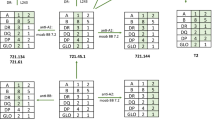Abstract
PRESENTATION of cytoplasmic antigens to class I-restricted cytotoxic T cells implied the existence of a specialized peptide transporter1–3 (reviewed in ref. 4). For most class I heavy chains, association with peptides of the appropriate length is required for stable assembly with β 2-microglobulin5–11. Mutant cells RMA–S (ref. 12) and .174/T2 (refs 13,14) neither assemble stable class I molecules nor present intracellular antigens, and we have suggested that they have lost a function required for the transport of short peptides from the cytosol to the endoplasmic reticulum5–7. The genetic defect in .174 has been localized to a large deletion in the class II region of the major histocompatibility complex6,15,16, within which two genes (RING4 and RING11) have been identified that code for 'ABC' (ATP-binding cassette) transporters15,17–21. We report here that the protein products of these two genes assemble to form a complex. Defects in either protein result in the formation of unstable class I molecules and loss of presentation of intracellular antigens. The molecular defect in a new mutant, BM36.1, is shown to be in the ATP-binding domain of the RING11/PSF2 protein. This is in contrast to the mutant .134 (ref. 15), which lacks the RING4/PSF1 protein.
Similar content being viewed by others
Author information
Authors and Affiliations
Rights and permissions
About this article
Cite this article
Kelly, A., Powis, S., Kerr, LA. et al. Assembly and function of the two ABC transporter proteins encoded in the human major histocompatibility complex. Nature 355, 641–644 (1992). https://doi.org/10.1038/355641a0
Received:
Accepted:
Issue Date:
DOI: https://doi.org/10.1038/355641a0
- Springer Nature Limited
This article is cited by
-
A personal retrospective on the mechanisms of antigen processing
Immunogenetics (2019)
-
Genetics of antigen processing and presentation
Immunogenetics (2019)
-
Introduction: MHC/KIR and governance of specificity
Immunogenetics (2017)
-
What is the role of alternate splicing in antigen presentation by major histocompatibility complex class I molecules?
Immunologic Research (2010)
-
MHC class I antigen presentation: learning from viral evasion strategies
Nature Reviews Immunology (2009)





